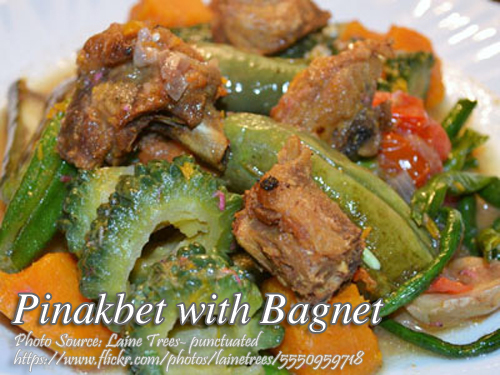One of the most popular Ilokano vegetable dish is “pinakbet”. It consists of eggplants, okra, squash, stingbeans, bagoong alamang or shrimp paste and spices. But the traditional ilokano pinakbet use bagoong isda (fermented fish sauce) instead of bagoong alamang.
Anyway this is a just a variation of the original recipe and actually this variation of pinakbet using shrimp paste is a kapampangan dish. Some people prefer bagoong alamang instead of bagoong isda but anyway you choose they are both delicious. Specially the crispy bagnet garnishing that makes this dish truly authentic.
A Hearty Twist on a Classic: Pinakbet with Crispy Bagnet
I spent my childhood amidst the busy kitchen of my Lola Nena, with the smell of vegetables stewing in the pot, the savor of shrimp paste, and the sounds of bagnet frying on the stove wafting through every corner of her cozy kitchen. It was there that I learned to appreciate the simple goodness that a hearty meal, like pinakbet, can offer. This is one of the favorite Ilocos dishes, where the earthy taste of fresh vegetables and salty bagoong isda or fermented fish sauce tell of its character. However, I learned through family gatherings and fiestas that it all spoke a story in variations-and today, we delve into another version inspired by Kapampangan using bagoong alamang or shrimp paste instead of fish sauce.
This crispy bagnet version of pinakbet carries not only the heart of Ilokano cuisine but also the Kapampangan flair for intense, rich flavors in one dish. The pungent hit of shrimp paste brings this medley of squash, eggplants, okra, and string beans together. It is the perfect example of how Filipino food can evolve and adapt while keeping its roots intact.
A Blend of Cultures in the Platter
This version of pinakbet was taught to me by my uncle, Tito Jun, who had lived in Pampanga for many years. He had bagoong alamang for a change instead of the bagoong isda that accompanied the usual dish. I was a bit resistant to it initially. Growing up with the old version of Ilokano pinakbet, I would always look forward to the sharp, savory taste that the fish sauce gave to the vegetables. But the very first spoonful of that squash was steeped with the richness of shrimp paste, and so, hooked on that taste, I found myself bringing it regularly.
The difference is minor, but the flavor is elevated to a whole other dimension. Alamang Bagoong is sweeter than fish sauce and less pungent; it lends a more balanced, subtle background to bright, fresh flavors of vegetables. Even newbs can be gently introduced to the taste of fermented fish as this dish is not too intense.
This adaptation, my sister Liza recounted, was very popular back home with her in-laws in Pampanga. She used to reject both versions each time she stayed with them, choosing the one that happened to suit the contents of her pantry. It had become a testament to how versatile Filipino cuisine is: how a single dish could be said to reflect not only the ingredients you have on hand but the story of where you come from.
The Magic of Bagnet: Crispy, Crunchy Perfection
Of course, what sets this one apart is the crispy bagnet at the top of this dish. Cousin Marco had gone to Laoag for the first time, and came home carrying a whole bag full of it. We fried the pieces until golden and crispy, and once added to the pinakbet, they transformed the whole dish. Each bite of tender vegetables seasoned perfectly with shrimp paste was finished with the crackle of the crunchy pork skin. It was bliss.
The secret to perfect bagnet is that you must fry the pork very, very crisp but still retains a juicy center. Others like the lechon kawali for a good substitute; it works just as well. Tito Jun even suggested we can use the chicken skin for a lighter twist. Whichever route you’d want to take, the crunch on top makes this dish go from being just a simple stir-fry of vegetables to something truly extraordinary. It is almost an entire sensory delight: the soft melting eggplant, firm, sweet squash, and that inescapable crunch of pork in every mouthful.
A Very Traditional Root, Constantly Under Evolution
In the past, pinakbet was born of necessity. What farmers of northern provinces managed to gather in their harvests they cooked up, putting fermented fish sauce for umami flavor into them. Practicality and flavor-enjoying were fused together in one practical dish made from meager ingredients. Over time, as families moved around the country, ingredients were swapped, and versions like the one with shrimp paste emerged. It is this flexibility which makes Filipino cuisine unique on how a single dish can evolve and adapt across different regions, all the while retaining its identity.
When I cook this dish today, I think of all the variations that have passed through my family’s kitchen over the years. The original Ilokano version with bagoong isda reminds me of summer vacations at my Lola’s house, because she served this one just simply with rice with fried fish on the side. The shrimp paste version of Kapampangan-inspired brings to mind memories from those Sunday lunches that Tito Jun always insisted on making the bagnet extra crispy. Small differences make the dish exciting and feel almost like it was cooked at home.
A Beginner’s Taste Adventure
If you’re a complete newcomer to Filipino food, this is a great place to start. No worries if you can’t find all the vegetables; substitute with what is fresh or available. Ampalaya or bitter melon adds a mild bitterness and thus balances the richness of shrimp paste, though some tend to leave it out as they do not like its taste. Now, magic sarap and ginisa mix can be added; although not part of the classic recipe, seasoning is definitely going to be easier for new cooks, and every mouthful will be full of flavor.
Patience is the secret key here. Simmer the vegetables long enough to soak all that bagoong flavor, but just to the point that they don’t get way too cooked and lose the texture of their crunch. And of course, do not forget that heavenly, crispy bagnet topping. Trust me when I say that once you taste this, this is the Kapampangan version that surely will find itself as a staple at your kitchen table, just as it has in mine.
How to Cook Ginisang Pinakbet with Bagnet
Ingredients
- 2 pcs small eggplants sliced into 2 inch pieces
- 1/4 kilo okra sliced into 1 inch pieces
- 2 pcs tomatoes diced
- 1/4 kilo squash slice into 1 inch
- 1 bunch stringbeans cut into 2 inch pieces
- 1 pc small ampalaya or bitter gourd sliced into 1/4 inch
- 4 cloves garlic crushed
- 2 pcs onions chopped
- 1 inch ginger slivered
- 1/2 kilo crispy chicken or lechon kawali
- 1 tsp. ginisa mix or magic sarap
- 2 Tbsp. shrimp paste or bagoong alamang
- 1/4 kilo pork with fat sliced into small cubes
- 2 Tbsp. cooking oil for sauteing
Instructions
How to cook Ginisang Pinakbet with Bagnet:
- Fry the 1/2 kilo chicken or fry the 1/2 kilo pork to make enough lechon kawali or bagnet.
- Fry until crispy and put into a strainer to remove extra oil. This will be used as a garnishing to the pinakbet dish.
- Heat oil in a pan and saute garlic, onion and ginger. Then follow the pork fat (you can use chicken fat as well).
- Then add the shrimp paste or bagoong alamang and the squash.
- Let it cook for 2 to 3 minutes then add the vegetables but you should put the eggplant and ampalaya first then the rest of the vegetables.
- Add the magic sarap and ginisa mix and mix the vegetables but be careful not to break the soft vegetables.
- Cover and simmer again for a few minutes until cooked.
- Serve hot and garnish with crispy chicken or bagnet on top.
Notes
Cooking Tips:
Fry the Bagnet for That Perfect Crunch
Dry the pork before frying to achieve the crunch when fried. It prevents splatter oil as well while frying. Fry in two steps: cook it through first, and then raise the temperature for that perfect signature crunchy bagnet. Remove excess oil from the strainer or place it on paper towels before putting the bagnet in the dish as if you never removed it.Balancing Vegetable Texture
Add the harder vegetables such as squash and eggplant before the softer ones like okra and ampalaya. Gently stir so the softer vegetables won't break apart as it simmers in the shrimp paste. Lookout for not to overcook; otherwise, the veggies will lose their color and crunch.Control of Saltiness in Shrimp Paste
This shrimp paste is saltier, though, so I use only a small amount at first, and adjust it to taste as I go. If the dish ends up too salty, adding in some squash or a splash of water will thin the sauce out enough to fix it. And topping it all with caramelized bagnet adds flavor, so don't forget to include this in your seasoning mixture.






With ginisang gulay as a healthy side, a bit of meat wouldn’t hurt. this looks great!
Hi Annie! You are right! Thanks for your comment!
Nakakamiss lutong pinoy
Hi Anna, yes you are right. So start cooking now.